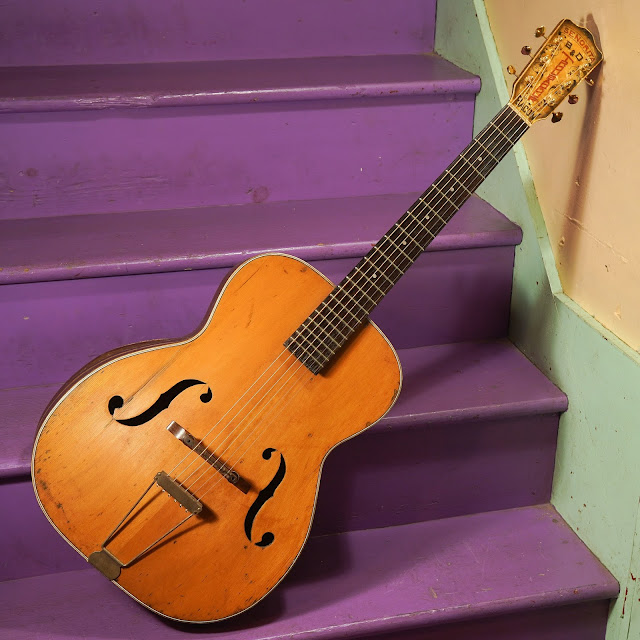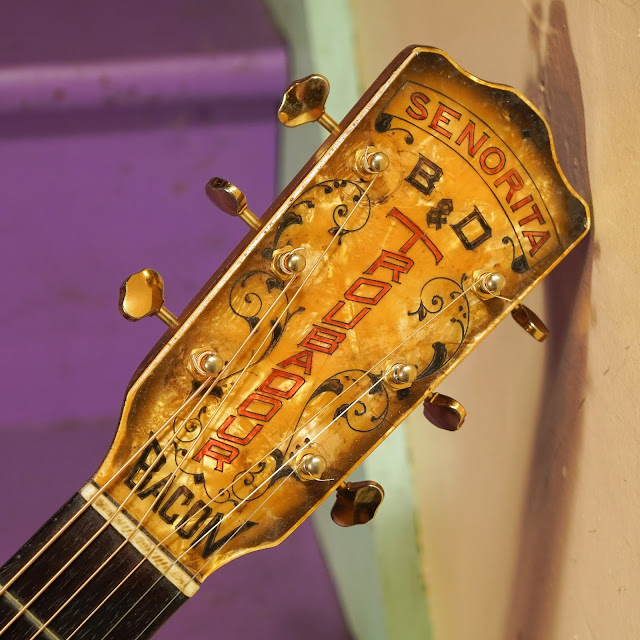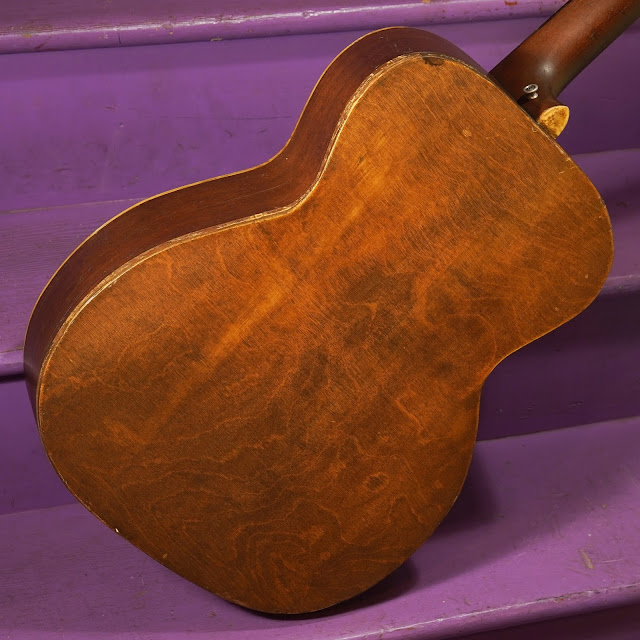1935 Bacon & Day Senorita Troubadour Archtop Guitar
There are two very different things going on with this particular guitar. The first is that it's awesome and then the second is that it's a doggone piece of garbage due to the condition.
Bacon did not sell many guitars and a lot of their wood-bodied instruments were made by Regal in Chicago -- including many of their archtops. I'm almost certain that this earlier model of carved-top, f-hole instruments wasn't, though, because it's not built in the same style or mold as any other preexisting Regal archtops... like most of the Bacon archtop lineup seems to have been composed of but with cosmetic changes... see here for a '32 round-hole Bacon tenor made by Regal.
Instead, whatever firm made those mysterious Armstrong guitars (click to see a beauty but take the old blog post info with a grain of salt) is exactly the same firm that made this iteration of Bacon archtops. The Armstrongs are almost identical in build, shape, neck style, construction, etc. -- all of which is very not typical of Regal carved-top instruments in any way. They're built like period Martins in many ways -- like an R-18 that wants to become a C-1 -- segmented f-holes (with a shape that matches no other mass-make routing jig profile I've seen), thin x-bracing, a "weirdo 000-like" body shape with square shoulders, and deep sides. I suppose Bacon could have made the instruments themselves and given-up on the idea, though.
At any rate, when these guitars are in good playing order, regardless of their make, they sound fantastic. This one is punchy, loud as heck, handles nicely, has a velvety "chuck" to its voice, and a nice, springy, compressed sound when dug-into.
This guitar, though, has been savaged. It should be an elegant instrument finished in a dark sunburst, fitted with a neat pickguard, and interesting adjustable bridge. It should be a slick package.
This guitar, however, is the reverse of elegant and slick. Someone has refinished it entirely (in "natural") and replaced the back with a piece of warped, twisted plywood. Copious amounts of bondo, filler, putty, and glue has been used to coax the new "back" into submission with the sides. The neck's heel was broken and "fixed" with a dowel installed under the heel cap, it has multiple sort-of-repaired hairline cracks on the top and scads more on the sides, and it was missing tuners, a tailpiece, and bridge. The neck was over-set (or, more likely, totally wonked-out by the replacement back "repair") and it was generally sad.
I figured it'd be a good instrument if given half a chance, though, and so I fixed it up despite the owner's best interests. Wait -- that doesn't sound right? This was one of those "do good enough and no more" repair jobs and ran under a couple hours total. The result is a guitar that plays bang-on and sounds tremendous, though, so I think it was all worth it.
Repairs included: heel repair (I ran a big screw/bolt into it under the heel cap to shore-up the old crack repair), fret level/dress, replacement (old) tailpiece install, replacement (new, hillbilly-lovely gold-plated Martin OM-42 cast-offs) tuners install, replacement (parts-bin-cobbled) bridge install, a couple of sealer coats of finish for the top, and setup.
Top wood: solid spruce (carved)
Back & sides wood: solid mahogany sides, random birch ply back
Bracing type: light x
Bridge: rosewood, adjustable
Fretboard: rosewood
Neck wood: mahogany
Action height at 12th fret: 3/32” bass 1/16” treble (fast, spot-on)
String gauges: 52w, 40w, 30w, 22w, 16, 12
Neck shape: medium soft V
Board radius: ~14"
Truss rod: non-adjustable steel
Neck relief: hair of relief tuned to pitch
Fret style: low/medium
Scale length: 24 5/8"
Nut width: 1 11/16"
Body width: 15"
Body depth: 4 3/8" + arching
Weight: 4 lbs 13 oz
Condition notes: I've written in length above, but suffice to say that it's... gnarly.




















Comments
At half past nine by the meet’n-house clock, —
Just the hour of the Earthquake shock!
What do you think the parson found,
When he got up and stared around?
The poor old chaise in a heap or mound,
As if it had been to the mill and ground!
You see, of course, if you’re not a dunce,
How it went to pieces all at once, —
All at once, and nothing first, —
Just as bubbles do when they burst.